
An electric guitar is a guitar that requires external amplification in order to be heard at typical performance volumes, unlike a standard acoustic guitar. It uses one or more pickups to convert the vibration of its strings into electrical signals, which ultimately are reproduced as sound by loudspeakers. The sound is sometimes shaped or electronically altered to achieve different timbres or tonal qualities from that of an acoustic guitar via amplifier settings or knobs on the guitar. Often, this is done through the use of effects such as reverb, distortion and "overdrive"; the latter is considered to be a key element of electric blues guitar music and jazz, rock and heavy- metal guitar playing. Designs also exist combining attributes of the electric and acoustic guitars: the semi-acoustic and acoustic-electric guitars.

The guitar is a fretted musical instrument that typically has six strings. It is usually held flat against the player's body and played by strumming or plucking the strings with the dominant hand, while simultaneously pressing selected strings against frets with the fingers of the opposite hand. A plectrum or individual finger picks may also be used to strike the strings. The sound of the guitar is projected either acoustically, by means of a resonant chamber on the instrument, or amplified by an electronic pickup and an amplifier.
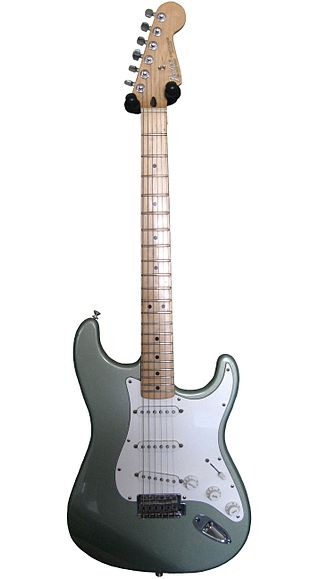
The Fender Stratocaster, colloquially known as the Strat, is a model of electric guitar designed between 1952 and 1954 by Leo Fender, Bill Carson, George Fullerton, and Freddie Tavares. The Fender Musical Instruments Corporation has continuously manufactured the Stratocaster since 1954. It is a double-cutaway guitar, with an extended top "horn" shape for balance. Along with the Gibson Les Paul, Gibson SG, and Fender Telecaster, it is one of the most-often emulated electric guitar shapes. "Stratocaster" and "Strat" are trademark terms belonging to Fender. Guitars that duplicate the Stratocaster by other manufacturers are sometimes called S-Type or ST-type guitars.

A single coil pickup is a type of magnetic transducer, or pickup, for the electric guitar and the electric bass. It electromagnetically converts the vibration of the strings to an electric signal. Single coil pickups are one of the two most popular designs, along with dual-coil or "humbucking" pickups.
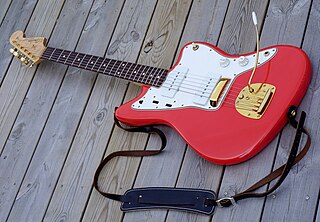
The Fender Jazzmaster is an electric guitar designed as a more expensive sibling of the Fender Stratocaster. First introduced at the 1958 NAMM Convention, it was initially marketed to jazz guitarists, but found favor among surf rock guitarists in the early 1960s. Its appearance is similar to the Jaguar, though it is tonally and physically different in many technical ways, including pickup design, scale length and controls.
The Fender Jaguar is an electric guitar by Fender Musical Instruments characterized by an offset-waist body, a relatively unusual switching system with two separate circuits for lead and rhythm, and a short-scale 24" neck. Owing some roots to the Jazzmaster, it was introduced in 1962 as Fender's feature-laden top-of-the-line model, designed to lure players from Gibson. During its initial 13-year production run, the Jaguar did not sell as well as the less expensive Stratocaster and Telecaster, and achieved its most noticeable popularity in the surf music scene. After the Jaguar was taken out of production in 1975, vintage Jaguars became popular first with American punk rock players, and then more so during the alternative rock, shoegazing and indie rock movements of the 1980s and 1990s. Fender began making a version in Japan in the mid-1980s, and then introduced a USA-made reissue in 1999. Since then, Fender has made a variety of Jaguars in America, Mexico, Indonesia and China under both the Fender and Squier labels. Original vintage Jaguars sell for many times their original price.

The Fender Precision Bass is a model of electric bass guitar manufactured by Fender Musical Instruments Corporation. In its standard, post-1957 configuration, the Precision Bass is a solid body, four-stringed instrument usually equipped with a single split-coil humbucking pickup and a one-piece, 20-fret maple neck with rosewood or maple fingerboard.
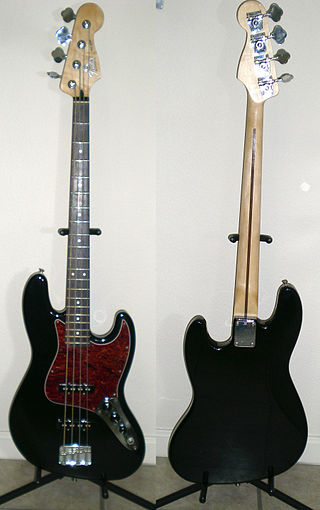
The Fender Jazz Bass is the second model of electric bass created by Leo Fender. It is distinct from the Precision Bass in that its tone is brighter and richer in the midrange and treble with less emphasis on the fundamental frequency. The body shape is also different from the Precision Bass, in that the Precision Bass has a symmetrical lower bout on the body, designed after the Telecaster and Stratocaster lines of guitars, while the Jazz Bass has an offset lower bout, mimicking the design aesthetic of the Jaguar and Jazzmaster guitars.
The Fender Bass VI, originally known as the Fender VI, is a six-string electric bass guitar made by Fender.

The Fender Eric Clapton Stratocaster is the signature model electric guitar of English guitarist Eric Clapton. It was the first signature model guitar released by Fender.
The Fender Katana is an electric guitar built by Fender. It was designed by marketing director Dan Smith in 1985. The Katana was designed to compete with the unconventionally-shaped guitars of the era, such as the Jackson Randy Rhoads, and to satisfy Fender dealers who were suffering from the competition those instruments offered. The Katana did not sell as well as Fender hoped, and it was discontinued in 1986 before being reissued as a Masterbuilt Custom Shop model as part of the Prestige collection three decades later.
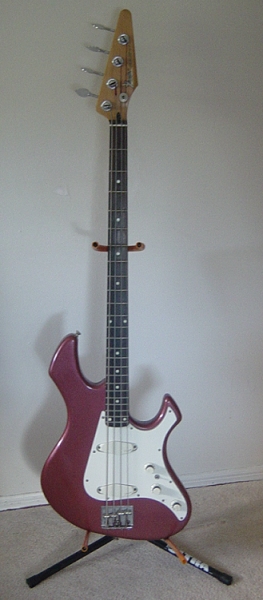
The Fender Performer was an electric bass guitar released in 1985 and discontinued in 1987, assembled in the United States and Japan. A Fender Performer electric guitar was also available.

Fender Contemporary Stratocaster electric guitars were produced by Fender Japan in the 1980s.
The Fender Bullet was an electric guitar originally designed by John Page and manufactured and marketed by the Fender Musical Instruments Corporation. It was first introduced as a line of "student" guitars to replace the outgoing Mustang and Musicmaster models.
The James Burton Telecaster is a Signature/Artist Series electric guitar made by Fender Musical Instruments Corporation. The guitar is available in two models, Upgrade and Standard, and both were designed by American country-rock guitarist James Burton along with Dan Smith at Fender. Both models are patterned after mid-century Fender Telecaster guitars played by Burton during his long career with Ricky Nelson, Elvis Presley, Merle Haggard, Emmylou Harris, John Denver and many other well-known artists.
The Jeff Beck Stratocaster is an electric solid body guitar made by Fender Musical Instruments for British guitarist Jeff Beck. This Artist Signature guitar was introduced in 1991 and upgraded ten years later. The Custom Shop version, introduced in 2004, is available in Olympic White and Surf Green finishes.
The Fender Elite Stratocaster is an electric solid body guitar that was manufactured by Fender in 1983 and 1984. The name was revived from 2016 to 2019 with the Fender American Elite Stratocaster Series.
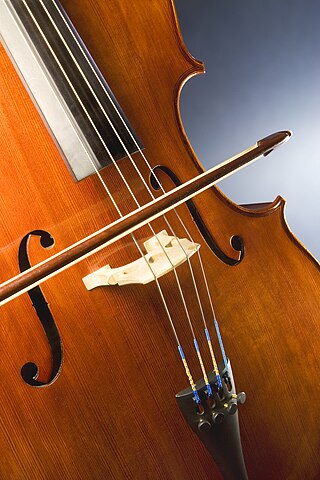
A bridge is a device that supports the strings on a stringed musical instrument and transmits the vibration of those strings to another structural component of the instrument—typically a soundboard, such as the top of a guitar or violin—which transfers the sound to the surrounding air. Depending on the instrument, the bridge may be made of carved wood, metal or other materials. The bridge supports the strings and holds them over the body of the instrument under tension.
The Yamaha Corporation is a multinational corporation and conglomerate based in Japan with a wide range of products and services, predominantly musical instruments, motorcycles, power sports equipment and electronics.
The Fender Telecaster, colloquially known as the Tele, is an electric guitar produced by Fender. Together with its sister model the Esquire, it was the world's first mass-produced, commercially successful solid-body electric guitar. Its simple yet effective design and revolutionary sound broke ground and set trends in electric guitar manufacturing and popular music.











